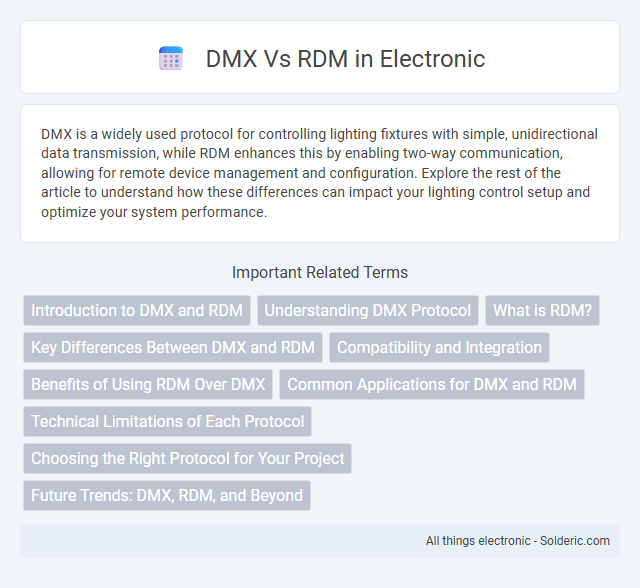DMX is a widely used protocol for controlling lighting fixtures with simple, unidirectional data transmission, while RDM enhances this by enabling two-way communication, allowing for remote device management and configuration. Explore the rest of the article to understand how these differences can impact your lighting control setup and optimize your system performance.
Comparison Table
| Feature | DMX (Digital Multiplex) | RDM (Remote Device Management) |
|---|---|---|
| Purpose | Standard protocol for lighting control | Enhanced protocol for bi-directional communication and device management |
| Communication Type | Unidirectional (controller to device) | Bidirectional (controller and device) |
| Device Configuration | Manual device addressing and setup | Remote device discovery and configuration |
| Protocol Standard | ANSI E1.11 (USITT DMX512-A) | ANSI E1.20 |
| Data Rate | 250 kbit/s | Same as DMX with added management commands |
| Compatibility | Supported by most lighting devices | Backwards compatible with DMX devices that support RDM |
| Error Reporting | No error feedback | Supports error detection and reporting |
| Use Cases | Basic lighting control systems | Complex systems requiring remote monitoring and troubleshooting |
Introduction to DMX and RDM
DMX (Digital Multiplex) is a standardized protocol used for controlling lighting and stage equipment in entertainment systems, enabling communication between controllers and fixtures through a unidirectional digital signal. RDM (Remote Device Management) builds upon DMX by adding bidirectional communication capabilities, allowing controllers to monitor and configure devices remotely. Both protocols are essential in modern lighting systems, with DMX providing basic control and RDM enhancing functionality through real-time feedback and device management.
Understanding DMX Protocol
The DMX protocol is a standard for digital communication networks commonly used to control lighting and stage effects, enabling devices to transmit data across a single cable with 512 channels per universe. RDM (Remote Device Management) enhances the DMX protocol by allowing two-way communication, facilitating remote configuration, status monitoring, and management of DMX-compatible devices. Understanding DMX's one-way communication limitations and how RDM's bidirectional capabilities improve control can optimize Your lighting setups and streamline device maintenance.
What is RDM?
RDM (Remote Device Management) is a protocol extension of DMX512 that enables two-way communication between lighting controllers and connected devices. It allows for remote configuration, status monitoring, and management of fixtures on a DMX network without interrupting the lighting signals. RDM enhances troubleshooting and setup efficiency by providing real-time feedback and control over compatible lighting equipment.
Key Differences Between DMX and RDM
DMX (Digital Multiplex) is a unidirectional protocol primarily designed for lighting control, sending commands from a controller to fixtures without device feedback, whereas RDM (Remote Device Management) enhances DMX by enabling two-way communication for remote configuration and status monitoring. RDM allows your fixtures to report errors, configuration data, and operational status back to the controller, improving troubleshooting and reducing setup time. The key difference lies in RDM's bidirectional capability, which adds advanced management features while maintaining compatibility with standard DMX devices.
Compatibility and Integration
DMX is widely compatible with most lighting fixtures and controllers, making it a standard protocol in stage lighting setups. RDM enhances this by enabling two-way communication, allowing devices to send status and configuration data back to controllers without interrupting DMX signals. Your lighting system can achieve greater integration and streamlined management by incorporating RDM-compatible equipment alongside traditional DMX hardware.
Benefits of Using RDM Over DMX
RDM offers enhanced two-way communication and device management capabilities compared to traditional DMX, allowing for real-time monitoring and configuration of lighting fixtures. This protocol reduces setup time and troubleshooting by providing remote addressing and status feedback, improving operational efficiency in complex lighting systems. Using RDM minimizes manual intervention and enhances overall system reliability in professional lighting environments.
Common Applications for DMX and RDM
DMX is widely used in theatrical lighting, concerts, and architectural installations for controlling multiple dimmers and intelligent fixtures with reliable, real-time data transfer. RDM enhances these setups by enabling bidirectional communication, allowing remote configuration, status monitoring, and troubleshooting of connected devices in live events and complex lighting systems. Both protocols support effective lighting control, but RDM's advanced features streamline maintenance and device management in large-scale productions and permanent installations.
Technical Limitations of Each Protocol
DMX protocol supports only unidirectional communication, limiting device feedback and monitoring capabilities, and operates at a fixed data rate of 250 kbps with a maximum of 512 channels per universe. RDM enhances this by enabling bidirectional communication for device configuration and status reporting but introduces higher complexity and requires compatible hardware, which can increase cost and setup time. Both protocols face challenges in scalability, with DMX restricted by channel count and RDM constrained by network management overhead and potential latency in large installations.
Choosing the Right Protocol for Your Project
Selecting between DMX and RDM depends on the project's needs for device control and feedback. DMX is ideal for straightforward lighting control with its widespread compatibility and simplicity. RDM enhances DMX by enabling bidirectional communication, offering remote configuration, status monitoring, and troubleshooting, making it suitable for complex setups requiring real-time device management.
Future Trends: DMX, RDM, and Beyond
DMX remains the industry standard for controlling stage lighting, but RDM (Remote Device Management) is revolutionizing setup and maintenance with two-way communication, enabling real-time device monitoring and configuration. Emerging protocols such as sACN and Art-Net are complementing DMX and RDM by offering enhanced scalability and network flexibility for complex lighting systems. Your lighting infrastructure can benefit from integrating these technologies, ensuring smoother workflows and readiness for future innovations in smart and automated environments.
DMX vs RDM Infographic

 solderic.com
solderic.com